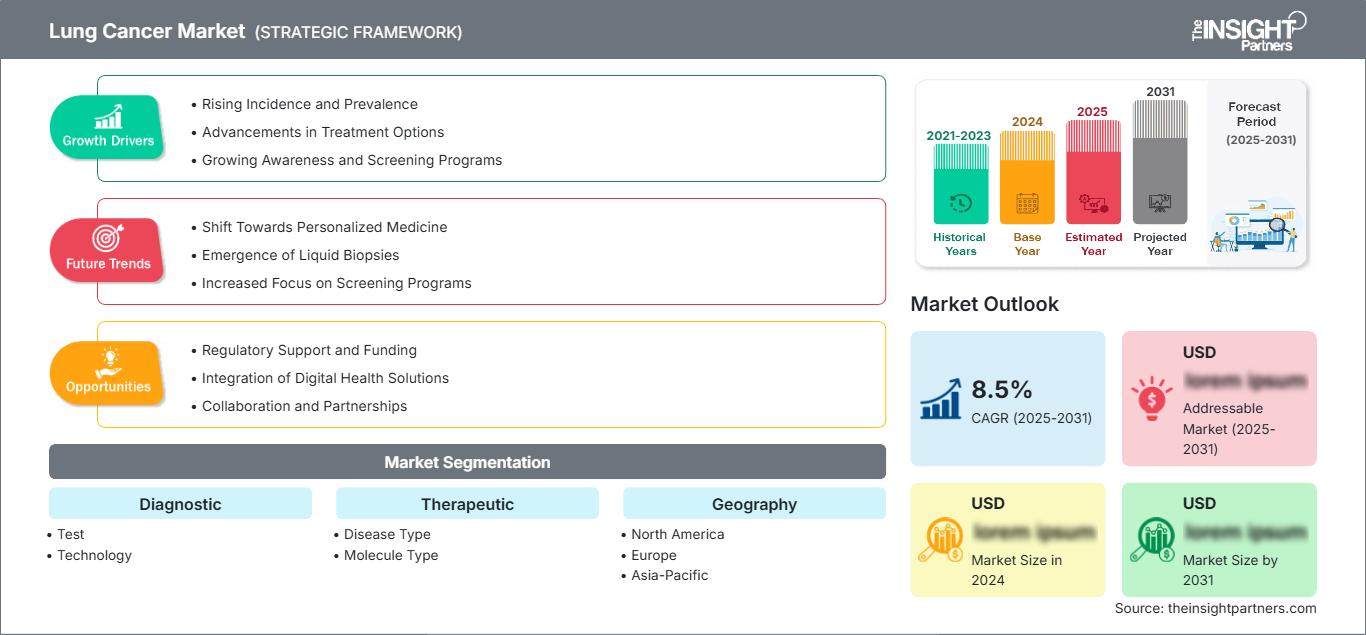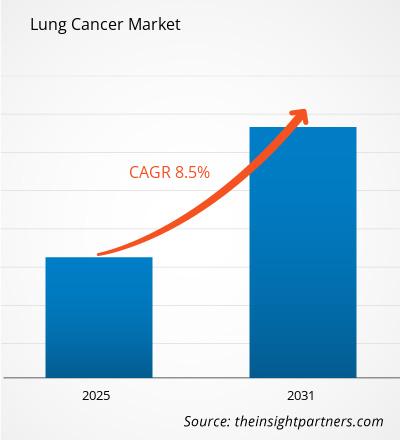Der Markt für Lungenkrebsdiagnostik wird bis 2031 voraussichtlich ein Volumen von 29,06 Milliarden US-Dollar erreichen. Für den Zeitraum 2025–2031 wird ein jährliches Wachstum von 8,4 % erwartet.
Der Bericht ist nach Diagnostik (Tests, Technologien) und Therapie (Krankheitsarten, Molekültypen) segmentiert. Die globale Analyse wird zudem auf regionaler Ebene und für wichtige Länder aufgeschlüsselt. Der Bericht enthält die Werte in US-Dollar für die oben genannten Analysen und Segmente. Der Bericht „Lungenkrebsmarkt“ von The Insight Partners beschreibt die aktuelle Marktlage, das zukünftige Wachstum, die wichtigsten Wachstumstreiber, Herausforderungen und Chancen. Dies wird verschiedenen Geschäftspartnern Einblicke bieten, wie zum Beispiel:
- Technologieanbieter/Hersteller: Um die sich entwickelnde Marktdynamik zu verstehen und potenzielle Wachstumschancen zu erkennen, damit sie fundierte strategische Entscheidungen treffen können.
- Investoren: Um eine umfassende Trendanalyse hinsichtlich der Marktwachstumsrate, der Finanzprognosen und der Chancen entlang der Wertschöpfungskette durchzuführen.
- Regulierungsbehörden: Um Richtlinien zu regulieren und Aktivitäten auf dem Markt zu überwachen, mit dem Ziel, Missbrauch zu minimieren, das Vertrauen der Investoren zu wahren und die Integrität und Stabilität des Marktes zu gewährleisten.
Marktsegmentierung für Lungenkrebs: Diagnostik
- Test
- Technologie
Therapeutik
- Krankheitsart
- Molekültyp
Sie erhalten kostenlos Anpassungen an jedem Bericht, einschließlich Teilen dieses Berichts oder einer Analyse auf Länderebene, eines Excel-Datenpakets sowie tolle Angebote und Rabatte für Start-ups und Universitäten.
Lungenkrebsmarkt: Strategische Einblicke

- Holen Sie sich die wichtigsten Markttrends aus diesem Bericht.Dieses KOSTENLOSE Beispiel umfasst Datenanalysen, die von Markttrends bis hin zu Schätzungen und Prognosen reichen.
Wachstumstreiber des Lungenkrebsmarktes
- Steigende Inzidenz und Prävalenz: Ein Grund für das Wachstum dieses Marktes ist die weltweit steigende Zahl von Lungenkrebsfällen. Rauchen, Umweltverschmutzung und sogar berufsbedingte Gefahren, wie beispielsweise die Belastung durch Dieselabgase bei Lkw-Fahrern und Bedienern schwerer Maschinen, tragen zu diesem Anstieg bei. Mit der Zunahme der Fälle steigt auch der Druck auf geeignete Behandlungsmethoden.
- Fortschritte bei den Behandlungsmöglichkeiten: Gezielte Therapien in Kombination mit Immuntherapien revolutionieren die Behandlung von Lungenkrebs. Die Charakterisierung onkogener Treiber bei Lungenkrebs ermöglicht eine patientenindividuelle und effektivere Behandlung. Präzisionsmedizin ist somit ein starker Markttreiber und treibt die Nachfrage nach spezifischen Therapien und verbesserten Behandlungsergebnissen für Patienten voran.
- Zunehmendes Bewusstsein und Screening-Programme: Das wachsende Bewusstsein für Lungenkrebs und seine Risikofaktoren hat zur Einrichtung von Screening- und Früherkennungsprogrammen geführt. Durch die verbesserte Früherkennung von Lungenkrebs sind die Überlebensraten nach der Therapie höher, und die Nachfrage nach verschiedenen Behandlungsformen steigt. Es besteht zudem ein ständiger Bedarf an Aufklärungskampagnen und Sensibilisierungsmaßnahmen zur Förderung von Vorsorgeuntersuchungen.
Zukunftstrends im Lungenkrebsmarkt
- Wechsel hin zur personalisierten Medizin: Der bedeutendste Trend ist derzeit die personalisierte Medizin, insbesondere in der Behandlung von nicht-kleinzelligem Lungenkrebs. Es zeichnen sich Fortschritte in der zielgerichteten Therapie ab, bei der die genetische Profilierung zu maßgeschneiderten Behandlungen führt, beispielsweise zu Therapieplänen, die den Patienten bestmögliche Ergebnisse ermöglichen. Diese Entwicklung wird durch die fortlaufende Forschung zu den molekularen Eigenschaften von Lungentumoren weiter unterstützt.
- Aufkommen von Flüssigbiopsien: Flüssigbiopsien werden zunehmend als Teil des Diagnose- und Nachsorgeprotokolls für Lungenkrebs mittels nicht-invasiver Methoden eingesetzt. Flüssigbiopsien können zirkulierende Tumor-DNA in Blutproben nachweisen. Dies wäre besonders hilfreich, um die Dynamik des Tumors und sein Ansprechen auf die Behandlung besser zu verstehen. Der Markt für Flüssigbiopsien dürfte mit dem technologischen Fortschritt und der Weiterentwicklung der Verfahren deutlich wachsen.
- Verstärkter Fokus auf Screening-Programme: Das Lungenkrebs-Screening entwickelt sich zu einem wesentlichen Bestandteil, um Lungenkrebs im Frühstadium zu erkennen. Fortschrittliche Screening-Programme für Hochrisikopatienten werden die Überlebensrate weiter verbessern. Daher wird der Markt für Lungenkrebs-Screening wachsen, da eine erfolgreiche Behandlung maßgeblich von der Früherkennung abhängt.
Marktchancen für Lungenkrebs
- Regulatorische Unterstützung und Finanzierung: Diese erfolgen in Form erhöhter Forschungsgelder und unterstützender regulatorischer Maßnahmen für Lungenkrebs. Organisationen wie die Lung Cancer Research Foundation und staatliche Initiativen stellen Zuschüsse und Fördermittel für die Erforschung neuer Behandlungsmethoden und Technologien bereit und schaffen so die notwendigen Mittel für neue Therapien sowie den Zugang zu bestehenden.
- Integration digitaler Gesundheitslösungen: Die Integration digitaler Gesundheitstechnologien, darunter Telemedizin und mobile Gesundheitsanwendungen, eröffnet ebenfalls neue Möglichkeiten in der Lungenkrebsversorgung. Diese technologischen Aspekte können die Einbindung der Patienten, die Fernüberwachung und den Zugang zur Versorgung für Patienten in unterversorgten Gebieten erleichtern. Unternehmen, die innovative, personalisierte digitale Lösungen für das Lungenkrebsmanagement anbieten, dürften dieses neue Marktinteresse wecken.
- Kooperationen und Partnerschaften: Eine potenzielle Partnerschaft zwischen einem Pharmaunternehmen, Forschungseinrichtungen und Gesundheitsdienstleistern kann den Weg für neue Behandlungsprotokolle und klinische Studien ebnen. Diese Art der Zusammenarbeit kann dazu beitragen, die Markteinführung neuer Behandlungen zu beschleunigen, indem alle Beteiligten ihre Ressourcen für die Weiterentwicklung der Lungenkrebsforschung bündeln. Dies wird wiederum die Gewinnmargen der beteiligten Parteien verbessern.
Markt für Lungenkrebs
Die regionalen Trends und Einflussfaktoren auf den Lungenkrebsmarkt im gesamten Prognosezeitraum wurden von den Analysten von The Insight Partners ausführlich erläutert. Dieser Abschnitt behandelt außerdem die Marktsegmente und die geografische Verteilung des Marktes für das Management von Herzrhythmusstörungen in Nordamerika, Europa, Asien-Pazifik, dem Nahen Osten und Afrika sowie Süd- und Mittelamerika.
Umfang des Marktberichts zu Lungenkrebs
| Berichtsattribut | Einzelheiten |
|---|---|
| Marktgröße in 2024 | US$ XX Billion |
| Marktgröße nach 2031 | US$ 29.06 Billion |
| Globale CAGR (2025 - 2031) | 8.4% |
| Historische Daten | 2021-2023 |
| Prognosezeitraum | 2025-2031 |
| Abgedeckte Segmente |
By Diagnose
|
| Abgedeckte Regionen und Länder | Nordamerika
|
| Marktführer und wichtige Unternehmensprofile |
|
Dichte der Akteure im Lungenkrebsmarkt: Auswirkungen auf die Geschäftsdynamik
Der Markt für Lungenkrebsmedikamente wächst rasant, angetrieben durch die steigende Nachfrage der Endverbraucher. Gründe hierfür sind unter anderem sich wandelnde Verbraucherpräferenzen, technologische Fortschritte und ein wachsendes Bewusstsein für die Vorteile des Produkts. Mit steigender Nachfrage erweitern Unternehmen ihr Angebot, entwickeln innovative Lösungen, um den Bedürfnissen der Verbraucher gerecht zu werden, und nutzen neue Trends, was das Marktwachstum zusätzlich beflügelt.

- Holen Sie sich die Lungenkrebsmarkt Übersicht der wichtigsten Akteure
Wichtigste Verkaufsargumente
- Umfassende Abdeckung: Der Bericht bietet eine umfassende Analyse der Produkte, Dienstleistungen, Typen und Endnutzer des Lungenkrebsmarktes und vermittelt so ein ganzheitliches Bild.
- Expertenanalyse: Der Bericht basiert auf dem fundierten Wissen von Branchenexperten und Analysten.
- Aktuelle Informationen: Der Bericht gewährleistet Geschäftsrelevanz durch die Berücksichtigung aktueller Informationen und Datentrends.
- Anpassungsmöglichkeiten: Dieser Bericht kann an spezifische Kundenanforderungen angepasst werden und sich optimal in die Geschäftsstrategien integrieren.
Der Forschungsbericht zum Lungenkrebsmarkt kann somit maßgeblich dazu beitragen, das Branchenszenario und die Wachstumsaussichten zu entschlüsseln und zu verstehen. Auch wenn einige berechtigte Bedenken bestehen, überwiegen die Vorteile dieses Berichts insgesamt die Nachteile.
- Historische Analyse (2 Jahre), Basisjahr, Prognose (7 Jahre) mit CAGR
- PEST- und SWOT-Analyse
- Marktgröße Wert/Volumen – Global, Regional, Land
- Branchen- und Wettbewerbslandschaft
- Excel-Datensatz
Aktuelle Berichte
Verwandte Berichte
Erfahrungsberichte
Grund zum Kauf
- Fundierte Entscheidungsfindung
- Marktdynamik verstehen
- Wettbewerbsanalyse
- Kundeneinblicke
- Marktprognosen
- Risikominimierung
- Strategische Planung
- Investitionsbegründung
- Identifizierung neuer Märkte
- Verbesserung von Marketingstrategien
- Steigerung der Betriebseffizienz
- Anpassung an regulatorische Trends






















 Kostenlose Probe anfordern für - Lungenkrebsmarkt
Kostenlose Probe anfordern für - Lungenkrebsmarkt